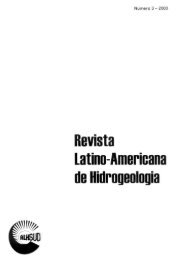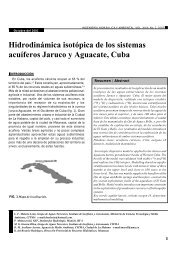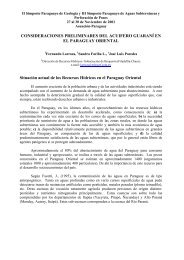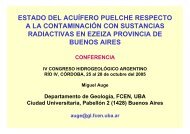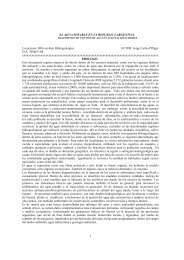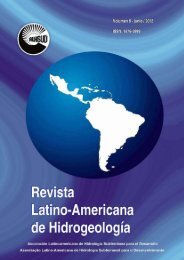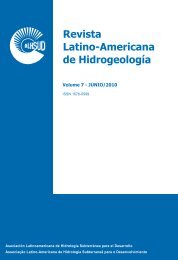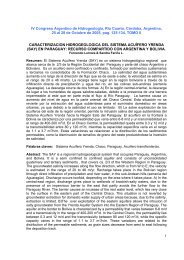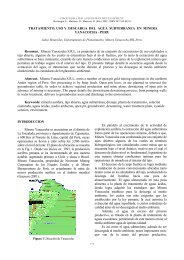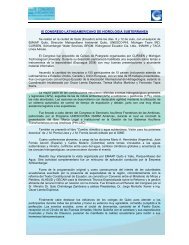ANÁLISIS DE LA VULNERABILIDAD INTRÍNSECA Y SUADECUACIÓN MEDIANTE UN MODELO DE FLUJO CONTRAZADO DE PARTÍCULAS PARA EVALUAR LAVULNERABILIDAD DEL ACUÍFERO DEL CURSO ALTO DELRÍO LERMA, ESTADO DE MÉXICOJ. GÁRFIAS 1R. FRANCO 2H. LLANOS 3ResumenEn este trabajo se presenta la evaluación de la vulnerabilidad del acuífero del altoLerma, Estado de México, México, mediante la aplicación combinada del métodoDRASTIC y el modelo numérico VisualModflow. El mapa de vulnerabilidadintrínseco fue adecuado, delimitandose nuevas áreas a proteger considerando lacontaminación en un plazo igual o menor a 50 años, adecuándose el análisis a lascondiciones de explotación del acuífero. Los cambios que se obtienen se reflejanen los índices de baja, media y alta vulnerabilidad. La estimación de la tasapromedio de cambio es del 43%, la cual refleja la incertidumbre entre lavulnerabilidad intrínseca y la vulnerabilidad específica. El hecho de considerar elflujo regional o el flujo local incide directamente en los resultados, por ello es difícilestablecer un criterio de comparación entre ambas metodologías. La elección delmejor método y el correcto manejo de la incertidumbre requiere la definiciónsimultanea del flujo local y regional. La única vía para cuantificar la aplicabilidad yla estimación de la incertidumbre, es comparar los resultados obtenidos con datosreales.Palabras clave: Vulnerabilidad, Visual Modflow, DRASTIC, Acuífero del altoLerma, Modelación, Contaminación.AbstractIn this wook, an evaluation of the vulnerability of the upper Lerma aquifer ispresented, using the combined application of the DRASTIC method and thenumerical model, visualModflow. The intrinsic vulnerability map was modified,delimiting new areas to protect, while considering the effects of contaminationwithin the next 50 years and analyzing the conditions of exploitation of the aquifer.The resulting changes are reflected in the of low, intermediate and highvulnerability index. The estimated rate of change is 43%, which reflects theuncertainty between the intrinsic vulnerability and the specific vulnerability. Simplyconsidering the regional flow or the local flow directly influences the results, and,therefore, it is difficult to establish criteria which compare between both methods.Chosing the best method and correctly handling the uncertainty requires thesimultaneous definition of local and regional flow. The only way to quantify theapplicability and evaluate the uncertainty is to compare the results obtained withreal data.Key words: Vulnerability, VisualModflow, DRASTIC, upper Lerma aquifer,modelling, contamination.1Facultad de Ingeniería (CIRA). Universidad Autónoma del Edo. de México. Toluca, México.2Facultad de Geografía. Universidad Autónoma del Edo. de México. Toluca, México.3Departamento de Geodinámica. Facultad de Ciencias. Universidad del País Vasco. Bilbao, España.Revista Latino-Americana de Hidrogeologia, n.2, p. 115-126, 2002. 115
GARFIAS, J. et al. Análisis de la vulnerabilidad intrínseca...1. IntroducciónEl agua subterránea comprende alrededordel 95% de los recursos útiles de agua dulce ydesempeña un importante papel en elmantenimiento de la humedad del suelo, elcaudal de los ríos y las zonas húmedas. Esterecurso “invisible” –almacenado entre la capaarenosa y las grietas rocosas bajo la superficiede la Tierra- es vulnerable a la polución y a lasobreexplotación. La contaminación de lasaguas de superficie es muy visible y por ello,capaz de poner en movimiento acciones yremedios para evitarla o, por lo menos, paratratar de paliarla. No sucede normalmente lomismo con las aguas subterráneas que, al no servisibles y estar su explotación muy distribuida, laacción protectora o paliadora llega confrecuencia tarde y ello en el supuesto de quellegue a producirse. Además, cuando lacontaminación se hace perceptible, usualmenteya ha alcanzado un importante desarrollo enextensión. La contaminación del agua continuaráen aumento a menos que se realicen mayoresesfuerzos de prevención, se incremente eltratamiento de aguas residuales y se utilicenformas más limpias y eficientes de producciónindustrial. Ello significa utilizar sustancias menostóxicas y reducir la emisión al medio ambiente demateriales potencialmente nocivos que seutilizan en la agricultura, la industria y a niveldomestico.En el caso particular de México, destacanla disminución acelerada de la disponibilidad deagua en las zonas más pobladas y la crecientecontaminación de los cuerpos de aguasusceptibles de servir como fuentes deabastecimiento. Éste es el caso del Estado deMéxico, que como consecuencia de lasactividades sísmicas de la ciudad de México, seconstituye actualmente como uno de los centrosindustriales más importantes del país. En estesentido, uno de los factores primordiales quesustentan el desarrollo del Estado de México esel agua subterránea. En efecto, la mayor partede las zonas industriales de la cuenca seabastecen mediante pozos profundos. Aunqueen algunas áreas la intensidad del bombeo estáocasionando efectos nocivos, como el descensoprogresivo de los niveles, infiltración decontaminantes y el agrietamiento del terreno.Como una manera de atenuar estasituación, se ha desarrollado programas deprotección de la calidad de las aguassubterráneas. Entre estos destacan tres líneasbásicas y casi siempre independientes deconducta: la primera está dirigida al acuíferodonde se definen las restricciones de uso de latierra frente a la vulnerabilidad, la contaminaciónde los acuíferos y la importancia del recurso116como fuente de abastecimiento público. En estecaso se considera la susceptibilidad natural quepresenta el acuífero frente a la contaminación, esdecir son áreas naturalmente vulnerables(vulnerabilidad intrínseca). Éstas son zonas mássensitivas donde el suelo, subsuelo, y las rocasno proveen adecuada protección y existe unpotencial para la transferencia rápida decontaminación al agua subterránea. Áreas deeste tipo son, por ejemplo, las zonas de recargade un acuífero somero.El segundo enfoque está dirigido a lospozos de captación, estableciendo perímetros deprotección alrededor de la obra, definidos a partirde los tiempos de tránsito específico, distanciade la fuente o el comportamiento hidráulico delacuífero. En este caso se considera el conceptode vulnerabilidad específica, que de acuerdo a laNational Academy Council (1993) se refiere a latendencia o probabilidad que un contaminantealcance una posición específica en el sistemaacuífero, después de su introducción en algúnpunto sobre el terreno. En muchos países, losmétodos para definir los perímetros deprotección son estandarizados usando diferentescriterios, basados en las cargas piezométricas,en el tiempo de transporte advectivo, en eltiempo del transporte advectivo dispersivo ootros parámetros. El tercer enfoque considera lasobreposición de las zonas más vulnerables, conmapas que muestran la localización de fuentespotencialmente contaminantes o actividades deluso del suelo que dan lugar a la contaminación,dando lugar a los mapas de riesgo (áreaspotencialmente problemáticas).Basados sobre estos diferentes enfoques,varios métodos han sido desarrollados paraestimar la vulnerabilidad. Ellos se extiendendesde modelos numéricos sofisticados quesimulan los procesos físicos, químicos ybiológicos que ocurren en el subsuelo (Derouaney Dassergues, 1998), hasta técnicas que usanun puntaje y un ponderador o peso para cadaparámetro. Muchos métodos clásicos devulnerabilidad están basados sobre esteenfoque: el método GOD (Foster, 1987), IRISH(Daly y Drew, 1999), AVI (Van Stempuoort et al.,1993), DRASTIC (Aller et al., 1987), SINTACS(Civita, 1994) y EPIK (Doerfliger y Zwahlen,1997). Cada método tiene un diferente criteriode ponderación de los parámetros involucrados;el método GOD asigna un igual peso para cadacaracterística hidrogeológica, y considera unrango más amplio de variación para laprofundidad al nivel freático. El método AVIsolamente considera importante a la zona nosaturada, sin considerar la porosidad que tienedicha zona. El método DRASTIC por su parteconsidera con mayor peso a los parámetrosRevista Latino-Americana de Hidrogeologia, n.2, p. 115-126, 2002.
- Page 9 and 10:
ESTRATEGIAS PARA PROTEGER LAS AGUAS
- Page 11 and 12:
LÓPEZ-VERA, F. Estrategias para pr
- Page 13:
LÓPEZ-VERA, F. Estrategias para pr
- Page 17 and 18:
ESTELLER, M.V. et al. Uso de Sistem
- Page 19 and 20:
ESTELLER, M.V. et al. Uso de Sistem
- Page 21 and 22:
Figura 3. Localización de los piez
- Page 23 and 24:
ESTELLER, M.V. et al. Uso de Sistem
- Page 25 and 26:
ESTELLER, M.V. et al. Uso de Sistem
- Page 27 and 28:
ESTELLER, M.V. et al. Uso de Sistem
- Page 29 and 30:
ESTELLER, M.V. et al. Uso de Sistem
- Page 31 and 32:
VULNERABILIDAD A LA INTRUSIÓN MARI
- Page 33 and 34:
MEDINA, M.R. et al. Vulnerabilidad
- Page 35 and 36:
MEDINA, M.R. et al. Vulnerabilidad
- Page 37 and 38:
MEDINA, M.R. et al. Vulnerabilidad
- Page 39 and 40:
MEDINA, M.R. et al. Vulnerabilidad
- Page 41 and 42:
MEDINA, M.R. et al. Vulnerabilidad
- Page 43 and 44:
MEDINA, M.R. et al. Vulnerabilidad
- Page 45 and 46:
MEDINA, M.R. et al. Vulnerabilidad
- Page 47 and 48:
MEDINA, M.R. et al. Vulnerabilidad
- Page 49 and 50:
MEDINA, M.R. et al. Vulnerabilidad
- Page 51 and 52:
MEDINA, M.R. et al. Vulnerabilidad
- Page 53 and 54:
XAVIER, J. M. et al. Evaluación de
- Page 55 and 56:
XAVIER, J. M. et al. Evaluación de
- Page 57 and 58:
XAVIER, J. M. et al. Evaluación de
- Page 59 and 60:
XAVIER, J. M. et al. Evaluación de
- Page 61 and 62:
XAVIER, J. M. et al. Evaluación de
- Page 63 and 64: ROSA FILHO, E.F. et al. Áreas de v
- Page 65 and 66: ROSA FILHO, E.F. et al. Áreas de v
- Page 67 and 68: ROSA FILHO, E.F. et al. Áreas de v
- Page 69 and 70: PROCESOS GEOQUíMICOS NATURALES E I
- Page 71 and 72: FAGUNDO, J.R. et al. Procesos geoqu
- Page 73 and 74: FAGUNDO, J.R. et al. Procesos geoqu
- Page 75 and 76: FAGUNDO, J.R. et al. Procesos geoqu
- Page 77 and 78: FAGUNDO, J.R. et al. Procesos geoqu
- Page 79 and 80: HIRATA, R. Carga contaminante y pel
- Page 81 and 82: HIRATA, R. Carga contaminante y pel
- Page 83 and 84: HIRATA, R. Carga contaminante y pel
- Page 85 and 86: HIRATA, R. Carga contaminante y pel
- Page 87 and 88: HIRATA, R. Carga contaminante y pel
- Page 89 and 90: HIRATA, R. Carga contaminante y pel
- Page 91 and 92: TUJCHNEIDER, O et al. Modelo de gé
- Page 93 and 94: TUJCHNEIDER, O et al. Modelo de gé
- Page 95 and 96: TUJCHNEIDER, O et al. Modelo de gé
- Page 97 and 98: TUJCHNEIDER, O et al. Modelo de gé
- Page 99 and 100: TUJCHNEIDER, O et al. Modelo de gé
- Page 101 and 102: TUJCHNEIDER, O et al. Modelo de gé
- Page 103 and 104: VULNERABILIDAD DE ACUÍFEROS FRENTE
- Page 105 and 106: ESTELLER, M.V. Vulnerabilidad de ac
- Page 107 and 108: ESTELLER, M.V. Vulnerabilidad de ac
- Page 109 and 110: ESTELLER, M.V. Vulnerabilidad de ac
- Page 111 and 112: ESTELLER, M.V. Vulnerabilidad de ac
- Page 113: ESTELLER, M.V. Vulnerabilidad de ac
- Page 117 and 118: GARFIAS, J. et al. Análisis de la
- Page 119 and 120: GARFIAS, J. et al. Análisis de la
- Page 121 and 122: GARFIAS, J. et al. Análisis de la
- Page 123 and 124: GARFIAS, J. et al. Análisis de la
- Page 125 and 126: GARFIAS, J. et al. Análisis de la
- Page 127 and 128: PEREZ, M. et al. Areas de reserva:
- Page 129 and 130: PEREZ, M. et al. Areas de reserva:
- Page 131 and 132: PEREZ, M. et al. Areas de reserva:
- Page 133 and 134: PEREZ, M. et al. Areas de reserva:
- Page 135: PEREZ, M. et al. Areas de reserva:



